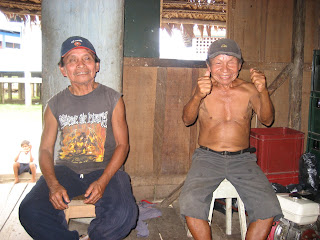Angel Raygada (from Iquitos) and Milano and Itolo (two brothers from Jenaro Herrera) have been helping CACE write down these lump stories for more than three years.
CACE monitors about 170 copal trees at the station. I´ve chosen three lucky winners to introduce to you.
Number ONE
 That ball between the legs of this copal tree is an orchid bee nest. These green bees made this nest mostly out of copal resin, with a bit of mud mixed in.
That ball between the legs of this copal tree is an orchid bee nest. These green bees made this nest mostly out of copal resin, with a bit of mud mixed in.Two months ago, Itolo spotted a green stingless bee on the nest. The bee crawled around the lump, left something (maybe resin?), and then buzzed away. This sighting is significant; we already knew that bees collect resin, but this is the first time we can correlate resin collection with nest building.
Yes, this bee actually is green! It's flashy like a disco ball.
Number TWO
 Angel and Itolo have been monitoring this tree for three years. They mark every resin lump with a white tag, as you see above. This big guy has 20 white tags, but no lumps. That's because someone stole all the lumps a few months ago, effectively trashing three years of data. The thieves probably used the resin to caulk their boat.
Angel and Itolo have been monitoring this tree for three years. They mark every resin lump with a white tag, as you see above. This big guy has 20 white tags, but no lumps. That's because someone stole all the lumps a few months ago, effectively trashing three years of data. The thieves probably used the resin to caulk their boat.Goes to show that even protected research stations aren't always protected.
But this guy is making a comeback. Campbell and I found a live weevil inside one of the cone traps. This trap takes advantage of the insect's ability to climb upwards and inability to navigate steep downhills. The weevil climbed up into the trap through a hole, but now he can't get down through that same hole.
And that enables us to take a good look at him. He is candy-corn sized, with brown scaly legs and a chunky torso:
 The light brown patch is the remnant of a weevil respiratory tube. For four months, the weevil larvae would periodically stick their head through the thin film of resin at the end of the tube. After a few minutes, the larvae would slide back down the tube, creating suction, which in turn enabled the resin to flow back into the tube, sealing the entrance.
The light brown patch is the remnant of a weevil respiratory tube. For four months, the weevil larvae would periodically stick their head through the thin film of resin at the end of the tube. After a few minutes, the larvae would slide back down the tube, creating suction, which in turn enabled the resin to flow back into the tube, sealing the entrance.We assume that these weevil larvae navigate up and down the tube in order to catch a breath of air.
Two months ago, the respiratory tube closed. We think that the larvae are still inside, and that their mother is still feeding them. Campbell hypothesizes that the tube has closed because the larvae are now going through an advanced larvae instar (sub-stage).
(The scientific community still doesn't know much about the life cycle of the weevil. Hence, the abundance of assumptions, thoughts, and hypothesis.)
At about the same time that the respiratory tube closed, another tube formed on top of the lump. Itolo says that this structure looks like the entrance of an orchid bee nest.
Itolo is going to fasten a trap around the lump in order to catch any weevil or bee adults that emerge from the resin as they mature. Neither Itolo nor Campbell have ever seen a lump with both weevil and bee activity. This could be the first!
These lump stories don't directly affect our production of essential oil from copal resin. They are primarily for educational, not commercial, purposes.
These tales teach us more about the fascinating relationships among resin, weevils, bees and copal trees. They encourage us to question:
If we take away this resin, what else will we change indirectly?
When we pull on this small, knotted string, how many big strings do we pull with it?
If we take away our tropical forests, what happens to us?
Maybe not much, but maybe a lot.
We don't know, not yet.
These lumps add to our understanding of ecology, of how our world works, of us.







